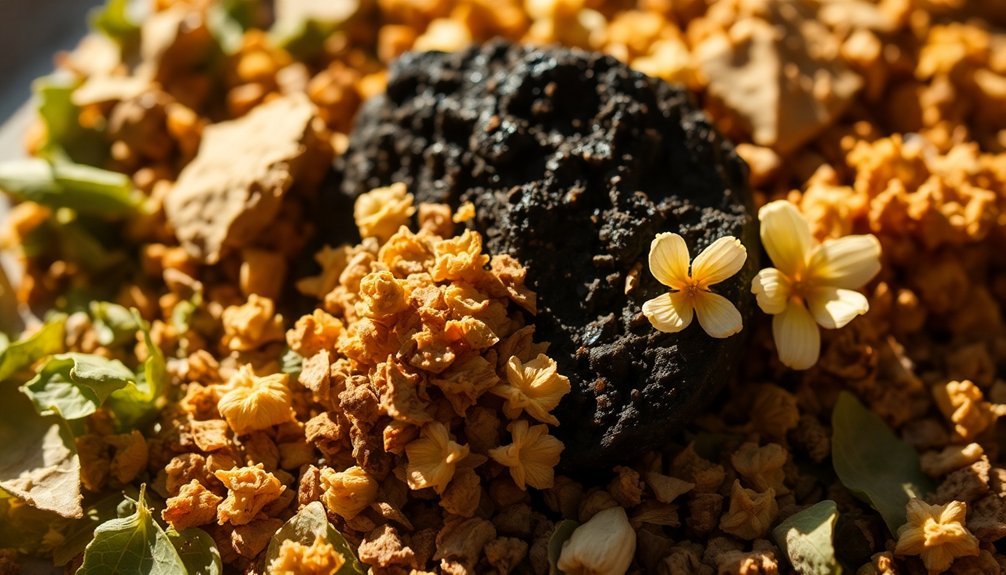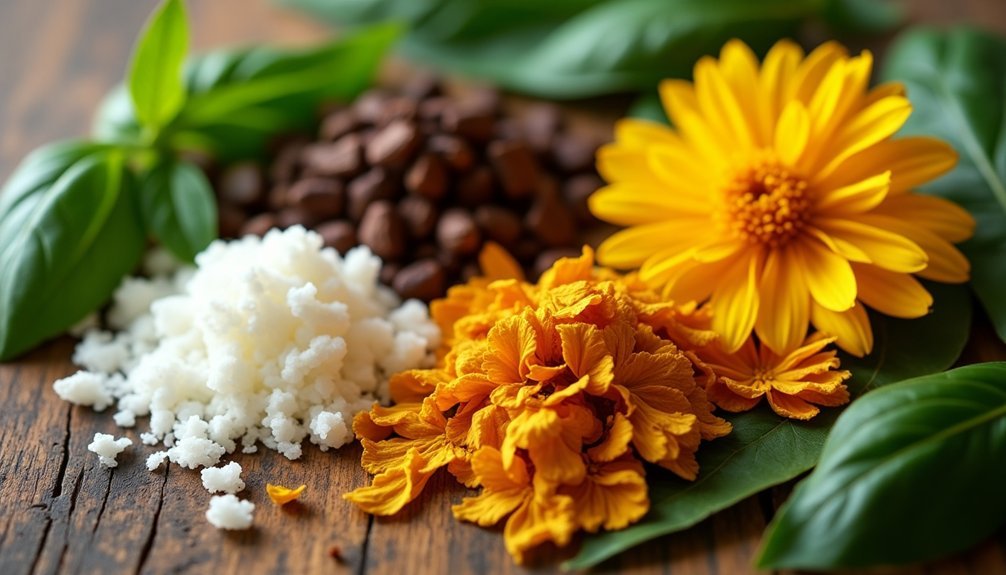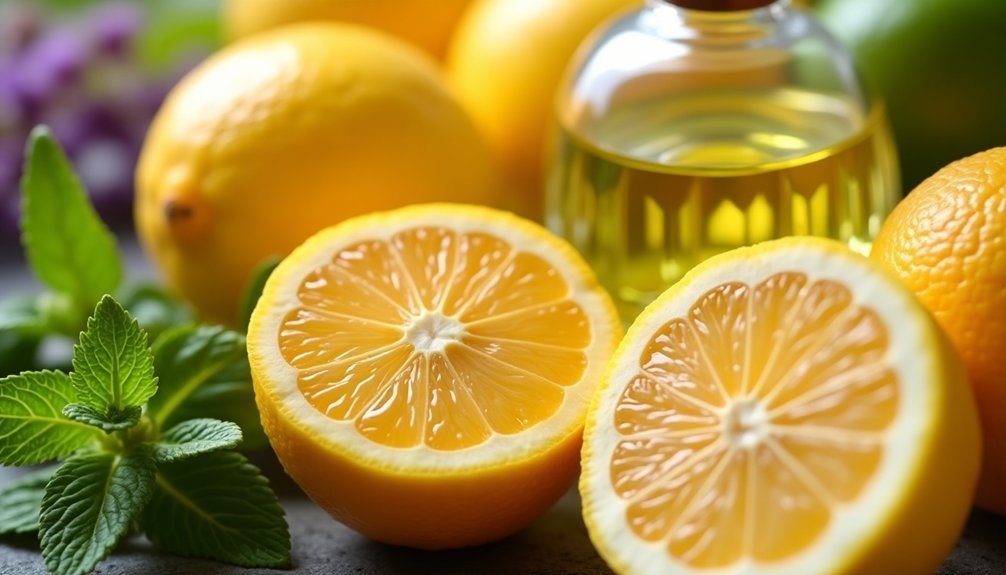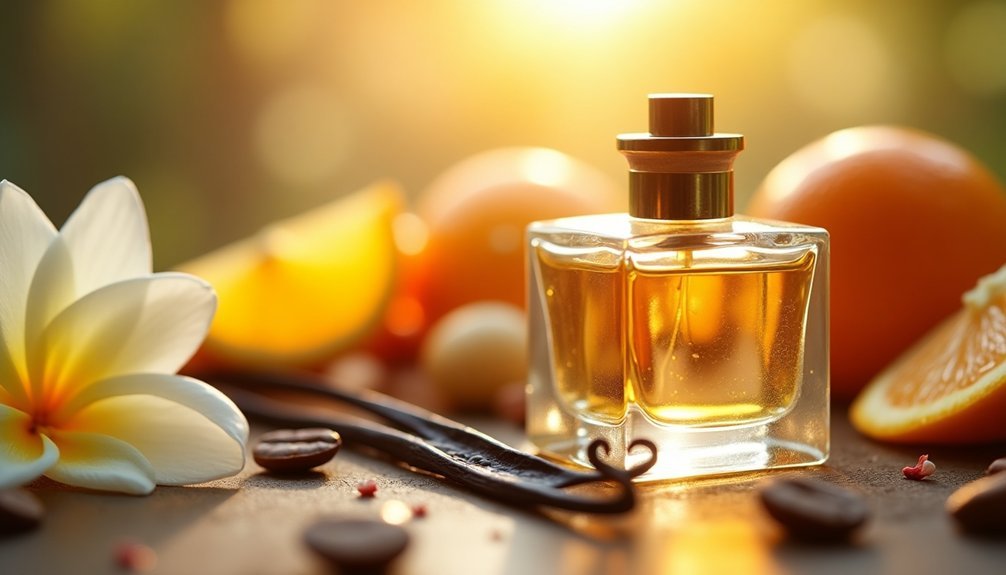You'll find several natural alternatives to replace ambrette seed musk in your fragrances. Tonka bean absolute offers rich, caramel-like sweetness, while galbanum delivers forest-fresh intensity. Angelica root provides a similar musky-green profile, and labdanum contributes warm, amber depth. Caraway seeds bring seedy muskiness, vetiver adds earthy complexity, and myrrh delivers sacred earthiness. Each botanical brings unique characteristics that'll transform your understanding of natural musk alternatives.
The Sweet Symphony of Tonka Bean Absolute

While ambrette seed musk remains a coveted fragrance ingredient, Tonka Bean Absolute offers a compelling plant-based alternative.
You'll find this precious extract derived from the seeds of the Dipteryx odorata tree, primarily sourced from Brazil and West Africa.
What makes Tonka Bean Absolute special is its rich, caramel-like aroma with powdery-sweet notes reminiscent of new-mown hay and warm tobacco.
It's a master of versatility in perfumery, working as both a non-floral sweetener and a fixative that enhances your fragrance's longevity.
With coumarin comprising 50-70% of its composition, you're getting a natural, safe alternative that's present in about 10% of modern quality perfumes.
The absolute appears as an off-white to brown paste-like mass that solidifies at room temperature.
It's particularly effective in chypres, fougères, and amber bases, where it harmonizes beautifully with vanilla, leather, and tobacco notes.
Galbanum: The Green Musky Marvel
You'll find galbanum's roots in ancient Persia, where this remarkable resin has offered its intense green, forest-like aroma for millennia.
Its distinct musky undertones and crisp verdant profile make it an excellent natural substitute for ambrette seed musk in contemporary perfumery.
When you're working with galbanum, you'll discover it pairs beautifully with floral notes, creating sophisticated compositions that bridge earthy and botanical elements. The resin's natural properties help stimulate blood flow throughout the body, enhancing its therapeutic value beyond just fragrance.
Ancient Persian Plant Source
Nestled in the arid mountain slopes of northern Iran and Central Asia, galbanum has served as a remarkable musky substitute since ancient times. This aromatic treasure comes from Ferula plants, which produce a milky juice that hardens into translucent, yellowish-brown lumps or tears.
- You'll find this ancient Persian plant thriving in both wild and cultivated settings, where it's been harvested for its unique properties since Egyptian times.
- The plant's resin contains a complex mix of compounds, including terpenes, sulfur-rich resins, and umbelliferone.
- You can recognize galbanum by its distinctive musky-green scent and bitter taste.
- It's particularly valuable in perfumery and traditional medicine, where you'll encounter it as an antispasmodic, anti-inflammatory, and antimicrobial agent. Modern perfume houses continue to utilize galbanum's unique properties in iconic fragrances like Chanel No. 19 and others.
Unique Forest-Fresh Profile
Beyond its ancient Persian origins, galbanum offers a fascinating forest-fresh profile that sets it apart from other musky substitutes.
You'll notice its powerful, complex aroma combining earthy, green, and spicy notes with a distinct musky undertone. Its honey-like consistency carries a rich blend of terpenes, including α-pinene and limonene, along with sulfur-containing resins.
You can use galbanum in multiple ways, as it serves both practical and aesthetic purposes. As a base note in perfumery, it's prized for its fixative properties, while its medicinal benefits include treating bronchitis and skin disorders.
Whether you're working with the soft grade for perfumery or the hard grade for pharmaceutical applications, you'll find that warming the substance improves its pourability for easier handling.
Blending With Floral Notes
When blending galbanum with floral notes, you'll discover its remarkable ability to enhance both delicate and bold fragrances. Its crisp, resinous character adds sophistication while harmonizing diverse scent components without overpowering them.
You'll find it's particularly effective in creating nature-inspired compositions that capture the essence of outdoor freshness.
- Pair galbanum with bergamot, lavender, rose, or jasmine for harmonious combinations that sing with natural energy.
- Use it to add depth and complexity to your floral blends, creating more sophisticated scent profiles.
- Leverage its leafy, herbal character to bring authentic green accents to your compositions.
- Take advantage of its smooth woody undertones to create balanced, multi-dimensional fragrances that tell a complete olfactory story.
Angelica Root's Complex Musky Profile
You'll find angelica root's musky-green aroma profile remarkably similar to ambrette, thanks to its cyclopentadecanolide content and complex blend of terpenes.
When harvesting angelica roots, you'll want to collect them in autumn of their first year or spring of their second year, when their aromatic compounds are most concentrated.
In perfumery applications, you can maximize angelica root's musk-like qualities by pairing it with earthy elements like patchouli and vetiver, while using minimal amounts due to its potent nature.
Scent Profile And Notes
Angelica root presents a fascinating olfactory profile that combines earthy, woody, and herbaceous qualities with distinctive musky undertones.
You'll discover a warm, spiced sweetness that creates depth and sophistication in natural perfume compositions.
- The top notes reveal peppery accents that gradually unfold into clean, spicy heart notes.
- The base notes showcase musky-woody characteristics, making it ideal for grounding blends.
- You'll find it pairs exceptionally well with resins and woods, enhancing natural formulations.
- Its remarkable tenacity means you'll need only small amounts to achieve lasting impact.
When working with angelica root, you're tapping into a complex aromatic that brings richness to both therapeutic and luxury perfume applications, while its persistent nature guarantees long-lasting scent projection.
Root Harvesting Best Practices
To achieve the richest musky profile from angelica root, proper harvesting timing and techniques prove essential.
You'll want to dig up the roots in fall of the first season or early spring of the second year, before the plant flowers. If you wait too long, the roots will become woody and lose their aromatic qualities.
Choose a dry day to harvest, ideally 3-4 days after rain. Cut back the foliage to about a foot above soil level, then carefully fork around each plant to avoid root damage.
For sustainable practices, harvest only one-third of your crop, leaving enough plants to flower and produce seeds.
After harvesting, divide large root balls and remove excess soil by hand. A light rinse in tepid water is sufficient – don't worry about removing every speck of soil.
Perfume Blending Applications
Once properly harvested, those earthy angelica roots reveal a treasure trove of aromatic possibilities in perfumery.
You'll find they're perfect for crafting heart and base accords, where their musky undertones and spicy-woody back notes add remarkable depth to your blends.
Here's how you can masterfully integrate angelica root into your perfumes:
- Combine with juniper berries and citrus for a fresh, spicy opening that captures attention
- Pair with resins like myrrh and wild labdanum to enhance the earthy complexity
- Blend with pine and oak moss to create a balanced, forest-inspired composition
- Mix with spicy and green notes for added sophistication in aromatherapeutic applications
Labdanum: Ancient Amber-Musky Essence
Through centuries of aromatic tradition, labdanum has earned its reputation as a treasured resinous essence that delivers a rich, amber-musky profile to perfumes and therapeutic preparations.
You'll find this versatile ingredient serving as a foundational base note in oriental and chypre fragrances, where it adds depth and warmth while acting as a natural fixative. Its balsamic sweetness, derived from vanillin and coumarin compounds, creates an enticing aura when blended with myrrh, frankincense, and floral essences.
Beyond its perfumery applications, you can harness labdanum's powerful antiviral and antibacterial properties for immune support.
It's particularly effective in skincare, helping to heal scars, soothe sun-exposed skin, and combat signs of aging. When used in aromatherapy, it'll help reduce stress and promote relaxation.
Caraway Seeds: A Spicy Musky Secret

While labdanum captures the amber-musky notes of nature's resins, caraway seeds offer an unexpected spicy-musky alternative in your aromatic palette.
You'll find Carum carvi's essential oil delivers a seedy, musky essence with a sweet-peppery undertone, enriched by carvone's distinctive herbal-minty quality.
- The oil's impressive longevity exceeds 24 hours on a smelling strip, making it a reliable base note in natural perfumery.
- Its warm, slightly dark, and sensual energy aligns perfectly with its historical use in love potions.
- You can distinguish it from similar spices by its crescent-shaped seeds with raised ridges.
- Its unique flavor profile balances fatty richness in foods while contributing nutty, bittersweet notes with hints of citrus and anise.
Vetiver's Earthy Musky Embrace
As nature's earthiest musk substitute, vetiver offers a complex aromatic journey from fresh, grassy top notes to deep, leathery base notes that'll remind you of rain-soaked soil. You'll discover its versatility in both elegant perfumes and earthy fragrances, where it adds depth and sophistication while extending longevity.
| Layer | Scent Profile | Blending Partners |
|---|---|---|
| Top | Fresh, Grassy | Citrus, Herbs |
| Middle | Woody, Sweet | Patchouli, Cedar |
| Base | Musky, Leathery | Sandalwood, Labdanum |
| Heart | Smoky, Nutty | Oriental Spices |
| Foundation | Balsamic, Warm | Amber, Vanilla |
When you're seeking a natural musk alternative, vetiver's rich heritage in traditional perfumery makes it an excellent choice. Its roots yield an essential oil that blends seamlessly with both fresh and woody compositions, creating a grounding effect that's perfect for contemporary fragrances.
Myrrh: The Sacred Musky Alternative

Since ancient times, myrrh has held a sacred place in both spiritual ceremonies and perfumery, offering a compelling alternative to traditional musk. Derived from the Commiphora tree's resin, this precious substance brings a rich, earthy aroma with complex notes of leather, spice, and subtle sweetness to your fragrance compositions.
- You'll find myrrh's long-lasting scent serves as an excellent fixative, making it ideal for creating natural musk accords when blended with cedarwood or patchouli.
- Its grounding properties work wonderfully in both masculine and feminine fragrances.
- You can harness its aromatherapeutic benefits for stress relief and emotional balance.
- The resin's natural origin offers a safer alternative to synthetic musks while providing antimicrobial and anti-inflammatory properties.
Consider incorporating this sacred resin into your next perfume creation for an authentic, earthy depth.
Frequently Asked Questions
Can These Natural Musk Alternatives Trigger Allergic Reactions in Sensitive Individuals?
Yes, you can experience allergic reactions to natural musks if you're sensitive, though they're less common than synthetic musk reactions. It's always wise to do a patch test before using any new ingredient.
How Do Plant-Based Musks Compare in Longevity to Synthetic Alternatives?
You'll find synthetic musks last notably longer than plant-based ones. While natural musks typically fade within hours, synthetic alternatives can persist for days on your skin and clothes, maintaining their scent profile.
What Temperature Conditions Best Preserve the Quality of Natural Musk Substitutes?
You'll want to store natural musk substitutes between 10-20°C (50-68°F) in a cool, dark place. Don't expose them to freezing temperatures or heat, and keep them away from direct sunlight.
Are These Plant-Based Musk Alternatives Ethically Sourced and Environmentally Sustainable?
Yes, you'll find natural musk alternatives are ethically sourced. They're harvested by hand from hibiscus plants, supporting sustainable farming practices without harming animals or ecosystems, unlike traditional musk from deer.
Can Different Natural Musk Alternatives Be Combined for Enhanced Fragrance Profiles?
Yes, you can blend different natural musk alternatives like Ambroxan, Ambrettolide, and white musk with plant-based fixatives such as labdanum and patchouli to create complex, long-lasting fragrances with enhanced depth.
In Summary
You've now discovered seven remarkable alternatives to ambrette seed musk that'll bring depth and character to your fragrances. Whether you're drawn to tonka bean's sweetness or vetiver's earthiness, these plant-based options offer unique musky profiles for your creative projects. Don't hesitate to experiment with different combinations of these natural substitutes to craft your own signature scent that's both sustainable and enchanting.





Leave a Reply